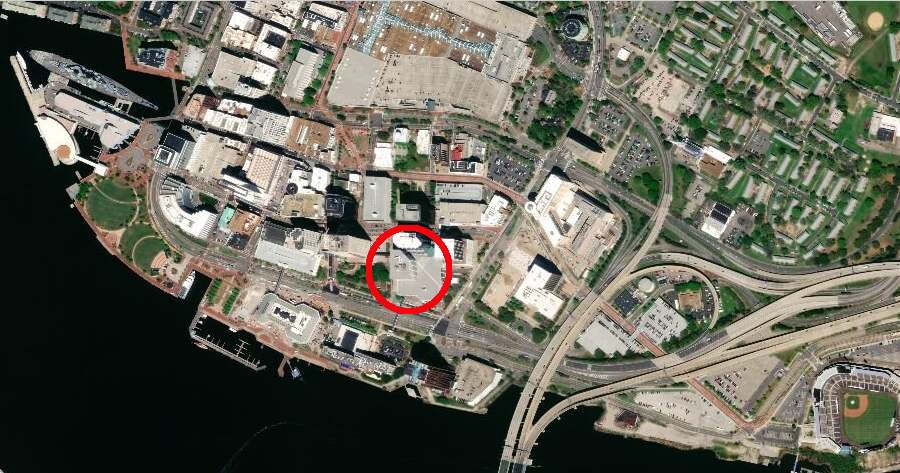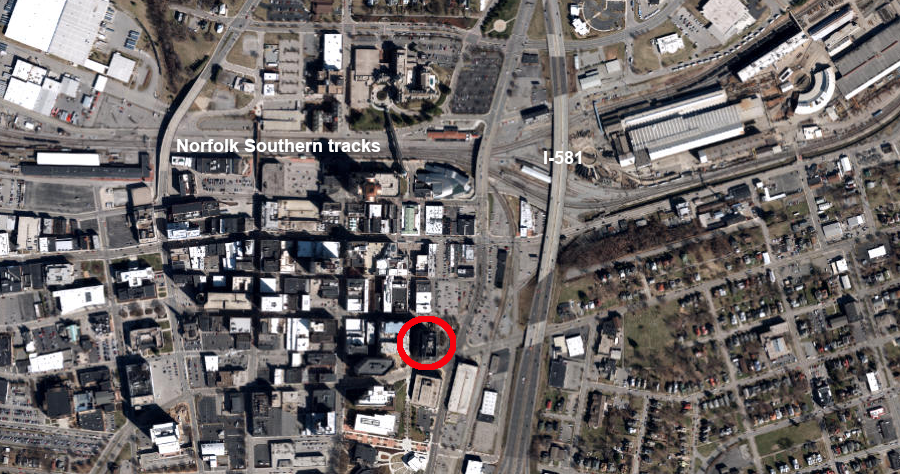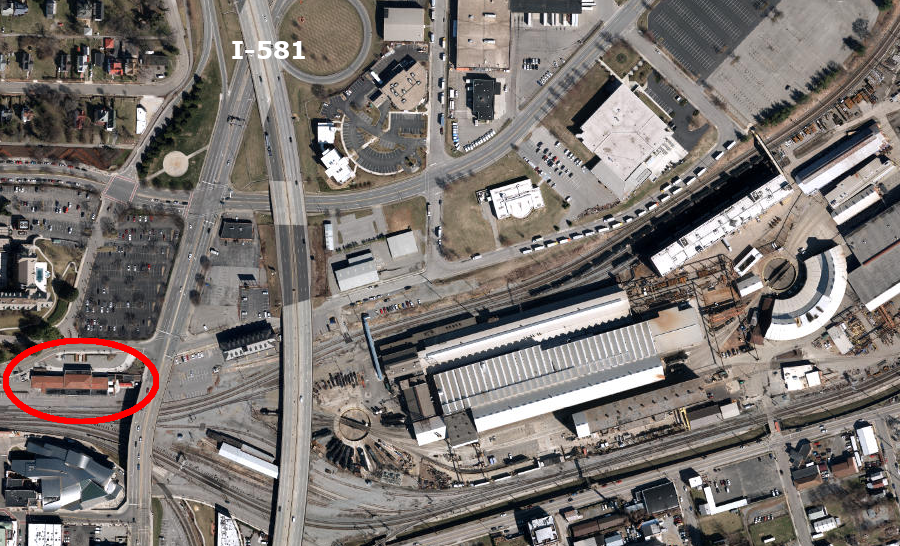 Norfolk Southern decided in 2018 to move its headquarters from its tower in Norfolk (circled) to Atlanta
Norfolk Southern decided in 2018 to move its headquarters from its tower in Norfolk (circled) to AtlantaSource: ESRI, ArcGIS Online
 Norfolk Southern decided in 2018 to move its headquarters from its tower in Norfolk (circled) to Atlanta
Norfolk Southern decided in 2018 to move its headquarters from its tower in Norfolk (circled) to Atlanta
Source: ESRI, ArcGIS Online
The swift growth of the "magic city" of Roanoke started when the Norfolk and Western Railroad chose the location of its junction. Big Lick grew into Roanoke after the Shenandoah Valley Railroad linked up there (and not at Bonsack or Salem) with the Virginia and Tennessee Railroad. The Norfolk and Western Railroad located its corporate headquarters in Roanoke until 1982.
In 1982 the Norfolk and Western Railway merged with the Southern Railway, which was based in Washington, DC. Officials of the new Norfolk Southern chose Norfolk as a neutral site for their headquarters, though many departments with most of the workers remained in Roanoke. The 22-story headquarters tower, known officially as the Arnold B. McKinnon Headquarters Building, opened in 1989 at 3 Commercial Place. The railroad's museum was located on the first floor.1
The Southern Railway had major facilities in Atlanta. The new Norfolk Southern expanded employment there, gradually shifting jobs to Georgia.
In 2015, Norfolk Southern closed its Roanoke office building at 110 Franklin Road SE in Roanoke. Most of the 500 jobs were moved to Atlanta.
To keep some of those jobs within the state, Virginia helped finance the transfer of marketing, accounting, information technology, and other workers to Norfolk. The 2015 transfers affected office workers, not the other 1,200 Norfolk Southern jobs at the local switching yard or locomotive and car maintenance facilities at Shaffer's Crossing.
In 2018, however, the railroad closed its Roanoke dispatching center and moved those 56 jobs to Atlanta.2
 in 2015, Norfolk Southern moved its office (circled) in downtown Roanoke
in 2015, Norfolk Southern moved its office (circled) in downtown Roanoke
Source: ESRI, ArcGIS Online
Roanoke leaders were unhappy in 2015 that the Virginia Secretary of Commerce and Trade used $2 million in the Commonwealth's Opportunity Fund to drain jobs from their city. Roanoke pointed out that the shift to Norfolk created no net gain of jobs in Virginia, while Roanoke lost 426 jobs.
Most workers moved to Atlanta or retired/resigned. Virginia did manage to get Norfolk Southern to transfer 165 jobs in the industrial products, coal marketing, sourcing, tax, treasury and audit and compliance departments to corporate headquarters in Norfolk.
State incentives included $2.5 million for rehabilitating the headquarters building as well as $2 million for relocation costs. Norfolk agreed to provide a $2.2 million subsidy for employee parking. The state funding came with strings attached; Norfolk Southern was required to retain the jobs in Virginia for 10 years.
Paying $40,000/job for only 10 years was a high price. Keeping the headquarters also helped continue the substantial charitable contributions made by Norfolk Southern in Virginia. However, the prestige of retaining a Fortune 500 corporate headquarters in Hampton Roads was a key factor.
The Roanoke Times reported in 2016 that officials in the Virginia Economic Development Partnership had been skeptical of the benefits of the deal for Virginia, especially the initial offer in which a state grant for rehabilitating the railroad's office building in Norfolk would exceed the private sector capital investment provided by Norfolk Southern. The newspaper story concluded:3
In 2018, Norfolk Southern and Atlanta revealed plans to move the company headquarters from Norfolk to the city in Georgia. Atlanta agreed to issue $600 million in bonds to finance a new headquarters building, part of a $6 billion plan to redevelop the "Gulch" area there.
The head of the Virginia Economic Development Partnership proposed that Norfolk Southern consolidate by moving all staff in Atlanta to Norfolk, but got a clear negative in response. The mayor of Norfolk, while upset at the potential loss of a Fortune 500 corporate headquarters, suggested that "clawing back" all $4 million of state and local subsidies given to Norfolk Southern would not affect the business decision to move to Atlanta.
Atlanta offered a larger pool of skilled workers, especially the legal, financial, and information technology talent required by Norfolk Southern to maximize efficiency in the competitive transportation sector. Norfolk was, by comparison to Atlanta, a small town with uncompetitive air service. The company had an opportunity to combine all key staff in one brand-new headquarters building financed by Atlanta, while selling its old office building there.
The mayor of Norfolk concluded that all efforts to retain Norfolk Southern's headquarters jobs would end up being a futile effort:4
Confirmation came officially on December 12, 2018. Downsizing of the railroad's headquarters operation was scheduled in two stages in 2020 and 2021, allowing families to base their moves around the school year.
Norfolk Southern agreed to return the incentive payments to Norfolk and the state. All $1.9 million of the state grant were returned. The value of the parking discount used to date in Norfolk, almost $600,000, was returned to the city. No future discount was allowed for future parking.
TowneBank and the and Children’s Hospital of the King’s Daughters partnered to purchase the 22-story Norfolk Southern Tower in 2020, paying just $30 million for a building with a value assessed at over $55 million. The railroad had officially called it the McKinnon Tower, honoring a former company executive. The shift in ownership meant that the names of two local institutions would be associated with the structure, and the memory of Norfolk Southern's role in the local community would fade.5
 Norfolk Southern Tower was sold and the name was changed in 2020
Norfolk Southern Tower was sold and the name was changed in 2020
Source: Wikipedia, List of tallest buildings in Norfolk, Virginia (by PghPhxNfk)
The loss of the Norfolk Southern headquarters still left Hampton Roads as the base for two Fortune 500 companies, Huntington Ingalls Industries in Newport News and Dollar Tree in Chesapeake. One site-selection expert noted:6
The Roanoke Times assessed the move from the perspective of the city that had once been the headquarters of the Norfolk and Western Railroad, and had lost the "white collar" jobs that Norfolk Southern had once based there.
In a snarky Dear Atlanta letter, the paper concluded that the shift from Norfolk was part of the structural change in the American economy from industrial production to services. It endorsed Richard Florida's thesis in The Rise of the Creative Class that only a few large cities with strong educational institutions will grow. The handful of magnet cities will attract the skilled personnel needed to perform jobs in the new service economy. The concentration of expertise will trigger relocation of existing businesses and spawn new companies, while existing smaller cities and rural areas will lose jobs and their population will shrink.7
The Roanoke Times and The Virginian-Pilot were owned by the same company. The sensitivity of the editorial staff may have been heightened by the two-stage loss of Norfolk Southern jobs from Roanoke to Norfolk to Atlanta. The Dear Atlanta letter finished with:8
In addition to white-collar jobs, Norfolk Southern eliminated most of its blue-collar jobs in Roanoke by 2020. The Norfolk and Western Railway had opened the Roanoke Machine Works in 1883 to construct and repair locomotives and rail cars. Between 1883-1953, the railroad built 447 steam locomotives at Roanoke, including:9
After the conversion to diesel, the Norfolk and Western Railway reduced employment at the shops for heavy repairs. Norfolk Southern once had 5,000 employees in Roanoke. Employment dropped to 3,100 in 1997, 1,700 in 2015, and 920 in 2019.
It maintained a distribution center, which stockpiled mechanical parts and shipped them to locomotive shops as needed. The last 85 mechanical jobs in the Locomotive Shop, plus 19 more clerical jobs in the Roanoke Distribution Center, were transferred to the Juniata Locomotive Shop in Altoona, Pennsylvania.
When Norfolk Southern completely closed down its remaining operations at the East End Shops, the railroad noted that it was shipping just 50% of the coal compared to 2008. Efforts to streamline the locomotive fleet had reduced their numbers by over 20% since 2018, and the need for maintenance was thus lower. After the transfer of jobs to Juniata in 2020, Norfolk Southern had only 650 employees in the Roanoke Valley.10
In 2005, FreightCar America leased space at the Norfolk Southern East End Shops to manufacture aluminum railroad freight cars. The private investment of over $5 million was projected to create 400 jobs.
The company received a $10 million Federal loan during the COVID-19 pandemic in 2020 to keep people employed. However, just five months later FreightCar America announced the transfer of the jobs to a facility in Mexico and closure of its operations in Roanoke.11
Roanoke still has railroad-related jobs thanks to a major railyard where freight cars, coal gondolas, and locomotives are stored and switched - but it is no longer a railroad city.
 the Locomotive Shop in Roanoke was located east of I-581 and the historic old passenger station (red circle)
the Locomotive Shop in Roanoke was located east of I-581 and the historic old passenger station (red circle)
Source: ESRI, ArcGIS Online
 Norfolk Southern's headquarters building in Norfolk, Virginia
Norfolk Southern's headquarters building in Norfolk, Virginia
Source: Wikipedia, List of tallest buildings in Norfolk, Virginia